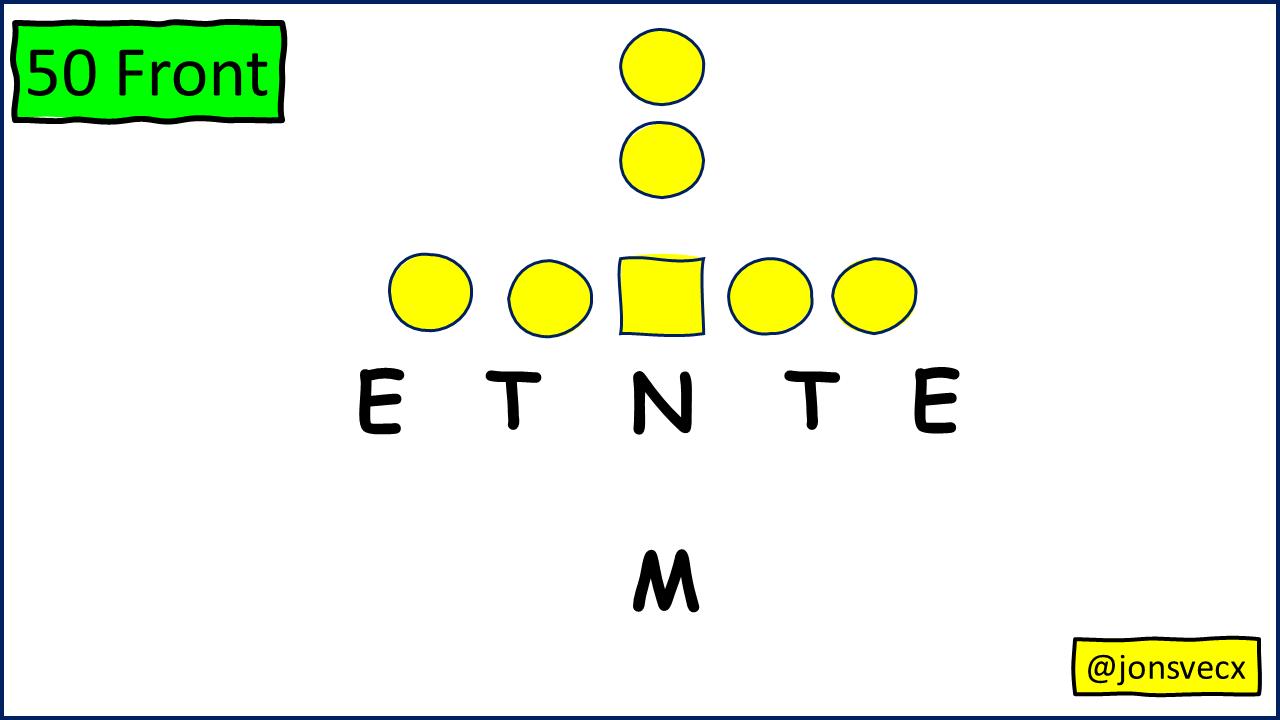50 Front Basics
Getting started with five down Linemen
Sometimes you just want to gear up on the line of scrimmage.
Whether you’re loading up the LOS on base downs, or packaging a 50 Front to match a certain look or situation, there’s a time and place for the 50.
Here are a few starting points.
What is the 50 Front?
In simple terms, the 50 Front includes five Defensive Linemen on the line of scrimmage. A basic alignment in a 50 Front would look like this:
In this look:
Defensive Ends are outside shade of the Offensive Tackles
Defensive Tackles are outside shade of the Offensive Guards
Nose is head up on Centre
Mike Linebacker is stacked over the Nose
Now, this day and age, there are many other ways to “get to” a 50 Front concept without five true Defensive Linemen. These concepts can be adapted to many personnel sets, but for the purpose of today’s newsletter, we’ll focus on the true 50.
Back End
Mathematically, going to a 50 Front is going to change some things on the back end.
As compared to a 40 Front, for instance, you are down one defender in Coverage. This means you’ll need to adjust your Coverages to fit your new numbers.
A common option here would be a Cover 1 Man-to-Man look. You can cover down every receiver, put the Mike LB on the RB, and still have deep help from the Free Safety. There are many Cover 3 options on the table here as well.
Nose Techniques
As with any Odd-type Front (ie. the 30), you’ll need a plan for your Nose.
The Nose aligns head up on the Centre, so which Gap should they control in the Run Game?
Two clear options emerge here.
One would be to designate either the Field A Gap or Boundary A Gap for the Nose. With this plan, the Nose will step to their designated shade of the Centre at the Snap, and control their appropriate Gap. Having this called into the play also tells the Mike LB which Gap they should control on the play.
Another option would be to have the Nose control the “Backside” Gap of the play. That is to say, if the Offence is running to the Field, the Nose will lag behind the Centre and control the Boundary A Gap. This tells the Mike to work over top to the Frontside A Gap.
Pros and Cons
Being this sturdy up at the line of scrimmage is a comforting concept, but there are always tradeoffs.
As opposed to a 40 Front, for example, you have one less “second level player” in the Run Game. This means you are slightly more susceptible to the Offence finding a crease and breaking a big run, especially on Gap Runs with moving Gaps.
Also, as I’ve already mentioned, you’re limited in your Coverage calls out of the 50.
Conversely, however, you can be very disruptive with this type of Front. Once you add some Stunting and some movement, there is great potential for making tackles in the backfield before the play even gets started.
Final Thoughts
As with anything, it often comes down to personnel. Do you have enough talented Defensive Linemen to get five out on the field at once? If so, the 50 Front might be a good addition to the playbook.
All the best,
Jon Svec
Defensive Coordinator
St. Francis Xavier University
X-Men Football
IG: @jonsvecx
Twitter: @jonsvecx
Jon Svec is the author of the e-book Canadian Football Chalk Talk: Defensive Basics.



